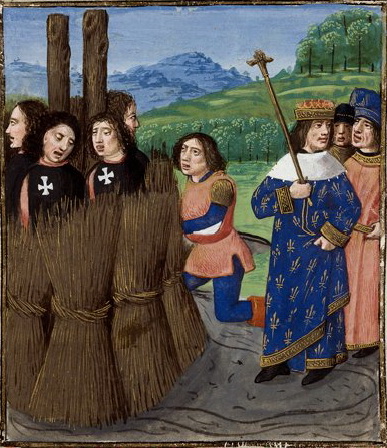|
Manuscript Culture
A manuscript culture is a culture that depends on hand-written manuscripts to store and disseminate information. It is a stage that most developed cultures went through in between oral culture and print culture. Europe entered the stage in classical antiquity. In early medieval manuscript culture, monks (or nuns) copied manuscripts by hand. They copied not just religious works, but a variety of texts including some on astronomy, herbals, and bestiaries. Medieval manuscript culture deals with the transition of the manuscript from the monasteries to the market in the cities, and the rise of universities. Manuscript culture in the cities created jobs built around the making and trade of manuscripts, and typically was regulated by universities. Late manuscript culture was characterized by a desire for uniformity, well-ordered and convenient access to the text contained in the manuscript, and ease of reading aloud. This culture grew out of the Fourth Lateran Council (1215) and the ... [...More Info...] [...Related Items...] OR: [Wikipedia] [Google] [Baidu] [Amazon] |
Flourished Initial "L" From A Medieval Manuscript
''Floruit'' ( ; usually abbreviated fl. or occasionally flor.; from Latin for 'flourished') denotes a date or period during which a person was known to have been alive or active. In English, the unabbreviated word may also be used as a noun indicating the time when someone flourished. Etymology and use is the third-person singular perfect active indicative of the Latin verb ', ' "to bloom, flower, or flourish", from the noun ', ', "flower". Broadly, the term is employed in reference to the peak of activity for a person or movement. More specifically, it often is used in genealogy and historical writing when a person's birth or death dates are unknown, but some other evidence exists that indicates when they were alive. For example, if there are wills attested by John Jones in 1204 and 1229, as well as a record of his marriage in 1197, a record concerning him might be written as "John Jones (fl. 1197–1229)", even though Jones was born before 1197 and died possibly after 12 ... [...More Info...] [...Related Items...] OR: [Wikipedia] [Google] [Baidu] [Amazon] |
Paper Quire
Various measures of paper quantity have been and are in use. Although there are no S.I. units such as quires or bales, there are ISO''ISO 4046-3:2002 Paper, board, pulps and related terms – Vocabulary – Part 3: Paper-making terminology'' (2002), quoted in ''ISO 22414:2004(E) Paper – Cut-size office paper – Measurement of edge quality'' (2004) Geneva:ISO. and DIN''Papier und Pappe: DIN 6730:2011-02: Begriffe'' (''Paper and board: vocabulary'') (2011) (in German). Berlin: Beuth Verlag. standards for the ream. Expressions used here include U.S. Customary Units. Units ; Writing paper measurements : 25 sheets = 1 quire : 500 sheets = 20 quires = 1 ream : 1,000 sheets = 40 quires = 2 reams = 1 bundle : 5,000 sheets = 200 quires = 10 reams = 5 bundles = 1 bale : 200,000 sheets = 8,000 quires = 400 reams = 200 bundles = 40 bales = 1 pallet ; 'Short' paper measurements : 24 sheets = 1 'short' quire : 480 sheets = 20 'short' quires = 1 'short' ream : 960 sheets = 40 'short' quir ... [...More Info...] [...Related Items...] OR: [Wikipedia] [Google] [Baidu] [Amazon] |
University
A university () is an educational institution, institution of tertiary education and research which awards academic degrees in several Discipline (academia), academic disciplines. ''University'' is derived from the Latin phrase , which roughly means "community of teachers and scholars". Universities typically offer both undergraduate education, undergraduate and postgraduate education, postgraduate programs. The first universities in Europe were established by Catholic Church, Catholic monks. The University of Bologna (), Italy, which was founded in 1088, is the first university in the sense of: *being a high degree-awarding institute. *using the word (which was coined at its foundation). *having independence from the ecclesiastic schools and issuing secular as well as non-secular degrees (with teaching conducted by both clergy and non-clergy): grammar, rhetoric, logic, theology, canon law and notarial law.Hunt Janin: "The university in medieval life, 1179–1499", McFarland, 2 ... [...More Info...] [...Related Items...] OR: [Wikipedia] [Google] [Baidu] [Amazon] |
Librarian
A librarian is a person who professionally works managing information. Librarians' common activities include providing access to information, conducting research, creating and managing information systems, creating, leading, and evaluating educational programs, and providing instruction on information literacy to users. The role of the librarian has changed over time, with the past century in particular bringing many new media and technologies into play. From the earliest libraries in the ancient world to the modern information hub, there have been keepers and disseminators of the information held in data stores. Roles and responsibilities vary widely depending on the type of library, the specialty of the librarian, and the functions needed to maintain collections and make them available to its users. Education for librarianship has changed over time to reflect changing roles. History The ancient world The Sumerians were the first to train clerks to keep records of accounts. '' ... [...More Info...] [...Related Items...] OR: [Wikipedia] [Google] [Baidu] [Amazon] |
Philip IV Of France
Philip IV (April–June 1268 – 29 November 1314), called Philip the Fair (), was King of France from 1285 to 1314. Jure uxoris, By virtue of his marriage with Joan I of Navarre, he was also King of Navarre and Count of Champagne as Philip I from 1284 to 1305. Although Philip was known to be handsome, hence the epithet ''le Bel'', his rigid, autocratic, imposing, and inflexible personality gained him (from friend and foe alike) other nicknames, such as the Iron King (). His fierce opponent Bernard Saisset, Roman Catholic Diocese of Pamiers, bishop of Pamiers, said of him: "He is neither man nor beast. He is a statue." Philip, seeking to reduce the wealth and power of the nobility and clergy, relied instead on skilful civil servants, such as Guillaume de Nogaret and Enguerrand de Marigny, to govern Kingdom of France, the kingdom. The king, who sought an uncontested monarchy, compelled his vassals by wars and restricted their feudal privileges, paving the way for the tran ... [...More Info...] [...Related Items...] OR: [Wikipedia] [Google] [Baidu] [Amazon] |
Jean Miélot, Brussels
Jean may refer to: People * Jean (female given name) * Jean (male given name) * Jean (surname) Fictional characters * Jean Grey, a Marvel Comics character * Jean Valjean, fictional character in novel ''Les Misérables'' and its adaptations * Jean Pierre Polnareff, a fictional character from ''JoJo's Bizarre Adventure'' * Jean Luc Picard, fictional character from ''Star Trek Next Generation'' Places * Jean, Nevada, United States; a town * Jean, Oregon, United States Entertainment * Jean (dog), a female collie in silent films * "Jean" (song) (1969), by Rod McKuen, also recorded by Oliver * ''Jean Seberg'' (musical), a 1983 musical by Marvin Hamlisch Other uses * JEAN (programming language) * USS ''Jean'' (ID-1308), American cargo ship c. 1918 * Sternwheeler Jean, a 1938 paddleboat of the Willamette River See also *Jehan * * Gene (other) * Jeanne (other) * Jehanne (other) * Jeans (other) * John (other) John is a common Eng ... [...More Info...] [...Related Items...] OR: [Wikipedia] [Google] [Baidu] [Amazon] |
Stationer
Stationery refers to writing materials, including cut paper, envelopes, continuous form paper, and other office supplies. Stationery usually specifies materials to be written on by hand (e.g., letter paper) or by equipment such as computer printers. History of stationery Originally, the term 'stationery' referred to all products sold by a stationer, whose name indicated that his book shop was on a fixed spot. This was usually somewhere near a university, and permanent, while medieval trading was mainly carried on by itinerant peddlers (including chapmen, who sold books) and others (such as farmers and craftsmen) at markets and fairs. It was a unique term used between the 13th and 15th centuries in the manuscript culture. Stationers' shops were places where books were bound, copied, and published. These shops often loaned books to nearby university students for a fee. The books were loaned out in sections, allowing students to study or copy them, and the only way to get the ne ... [...More Info...] [...Related Items...] OR: [Wikipedia] [Google] [Baidu] [Amazon] |
University Of Paris
The University of Paris (), known Metonymy, metonymically as the Sorbonne (), was the leading university in Paris, France, from 1150 to 1970, except for 1793–1806 during the French Revolution. Emerging around 1150 as a corporation associated with the cathedral school of Paris, it was considered the List of medieval universities, second-oldest university in Europe.Charles Homer Haskins: ''The Rise of Universities'', Henry Holt and Company, 1923, p. 292. Officially chartered in 1200 by Philip II of France, King Philip II and recognised in 1215 by Pope Innocent III, it was nicknamed after its theological College of Sorbonne, founded by Robert de Sorbon and chartered by King Louis IX around 1257. Highly reputed internationally for its academic performance in the humanities ever since the Middle Ages – particularly in theology and philosophy – it introduced academic standards and traditions that have endured and spread, such as Doctor (title), doctoral degrees and student nations. ... [...More Info...] [...Related Items...] OR: [Wikipedia] [Google] [Baidu] [Amazon] |
Italy
Italy, officially the Italian Republic, is a country in Southern Europe, Southern and Western Europe, Western Europe. It consists of Italian Peninsula, a peninsula that extends into the Mediterranean Sea, with the Alps on its northern land border, as well as List of islands of Italy, nearly 800 islands, notably Sicily and Sardinia. Italy shares land borders with France to the west; Switzerland and Austria to the north; Slovenia to the east; and the two enclaves of Vatican City and San Marino. It is the List of European countries by area, tenth-largest country in Europe by area, covering , and the third-most populous member state of the European Union, with nearly 59 million inhabitants. Italy's capital and List of cities in Italy, largest city is Rome; other major cities include Milan, Naples, Turin, Palermo, Bologna, Florence, Genoa, and Venice. The history of Italy goes back to numerous List of ancient peoples of Italy, Italic peoples—notably including the ancient Romans, ... [...More Info...] [...Related Items...] OR: [Wikipedia] [Google] [Baidu] [Amazon] |
Limner
A limner is an illuminator of manuscripts, or more generally, a painter of ornamental decoration. A mention of medieval limners' work appears in the book ''Methods and Materials of Painting'' by Charles Lock Eastlake (1793–1865). United Kingdom In London in the mid-19th century the limner David Laurent de Lara established himself as a modern illuminator of manuscripts and documents. His work broke new ground and helped establish the idea of illumination as a contemporary artform in its own right, rather than as a historical artform. The office of His Majesty's Painter and Limner is a position within the Royal Household unique to Scotland. It was last held by Dame Elizabeth Blackadder until her death in 2021. The position of portrait painter to the royal household is honorary and for life. United States In early 19th-century America, a limner artist was one who had little if any formal training and would travel from place to place to solicit commissions. Among colonial ... [...More Info...] [...Related Items...] OR: [Wikipedia] [Google] [Baidu] [Amazon] |






